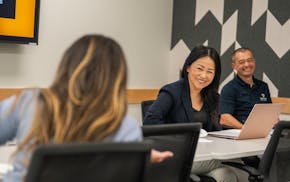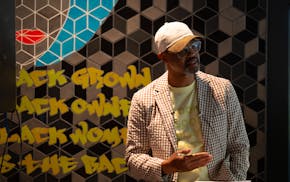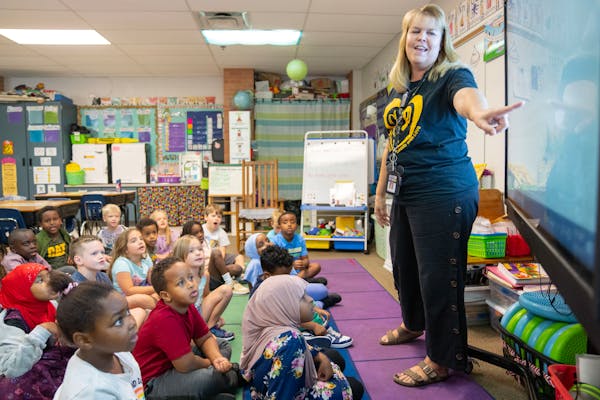When school started last fall, University of Minnesota student-teachers working at Global Academy, a K-8 charter school in New Brighton, asked Global's teachers to list their hopes for them.
"I said 'I want them to stay in education,' because there's such a shortage of teachers," said Rachel Enderlein, who has taught kindergartners and first-graders at Global since graduating from the U 16 years ago.
"They were kind of shocked when I said that to them," she added. "I just said, 'I want you to see what is doable and to find that love of teaching that we have found.'"
I've visited some charter schools in recent months to learn how they sparked competition in public education, and how they affect Minnesota's economy. I'll write more about them in coming weeks. Global stands out because of how it is run.
A distinctive element of the 1991 law that created charter schools in Minnesota was that a majority of seats on their governing boards had to be given to licensed teachers working in the school. That changed in 2009, and many charter schools are now led by boards with a mix of administrators, parents and community members, looking more like the elected school boards of public school districts.
Global's nine-person governance board is still controlled by its teachers.
"You can't replace a teacher's knowledge for knowing what's best for a school. So we stay as a teacher-majority board and will always be that way as far as I'm concerned," said Melissa Storbakken, who co-founded Global in 2006, worked for many years as a teacher and became its executive director last fall.
Each summer, Global's teachers meet to revisit and reconsider what they call the "essential agreements" for running the school. They cover not just big things like the curriculum but smaller details like how students move through the building, which is quiet with teachers using hand signals and signboards to direct them.
"Everything's thought out, even the routes in the hallways," said Lauren Greiner, who joined Global last fall as a fourth-grade teacher. "If I have a new idea, I feel comfortable bringing it up and they tell me go ahead and try it."
Many charter schools find a niche of families to whom they appeal. Global's sprung from the desire of Storbakken and co-founder Helen Fisk to start a school with an international baccalaureate curriculum. They were teaching at another charter school with a sizable number of Somali students, and it was some families from that school who initially signed up when they opened Global.
"We didn't open the school thinking we would only be serving East Africans. The school is open to anybody who wants to come," Storbakken said. She added that the Somali families they knew "were gracious and trusting and very much accepted us for our all of our mistakes that we made."
About 85% of Global's 450 students are children of Somali immigrants or themselves are Somali immigrants. The school provides uniforms and transportation for them. The waiting list to get in has 600 names on it. As with all charter schools that are in high demand, admission is determined by lottery.
Ayan Barre, who has been the school's office manager from its start, has the difficult task of managing parents' expectations. "They call us two years prior" to enrolling students, she said. "I tell them 'OK, you're on the wait list.' They say 'What?'"
Global has consistently appeared on the Star Tribune's list of schools that "beat the odds," which compares test outcomes against estimated income of students' families. While having one of the highest rates of students qualifying for free and reduced lunch, Global also had the highest reading scores, with nearly 60% of students at grade-level proficiency.
Its math scores are not as high, though still higher than most schools with a similar economic makeup. Charise LaVelle, who is the assistant director in charge of the middle school at Global, said teachers are feeling pressure from parents to improve math skills. She provides email updates about curriculum changes underway.
"We're pretty responsive on what's not working and what we need to do about it," LaVelle said.
The Star Tribune profiled the school in 2013 when it was achieving similar results while occupying a portion of a strip mall. Today, Global operates in the building that for years was home to United Theological Seminary. The seminarians' apartments are gone and there's now a playground and two gymnasiums for Global's students, who have physical education classes daily.
When I asked Storbakken why — when there's such demand — Global hasn't expanded, she referenced research showing the most effective schools have fewer than 500 students. Smaller size allows students and their families to develop stronger relationships with teachers, she added.
"Really what it comes down to is good teachers in the classrooms who have a lot of professional development, a lot of autonomy and agency and that makes them happy," Storbakken said. "If a student sees their teacher is happy, they want to come to school. Kids in seats, you educate them. That's how you get it done."

Ramstad: Readers say Walmart won't be paying the ultimate price of Trump's tariffs

Ramstad: Gov. Walz, things are not getting done in Minnesota

Ramstad: AI is English-centric, but it's picking up Hmong quickly

Ramstad: Minneapolis' Camden neighborhood is rising. Houston White wants to keep it that way.



